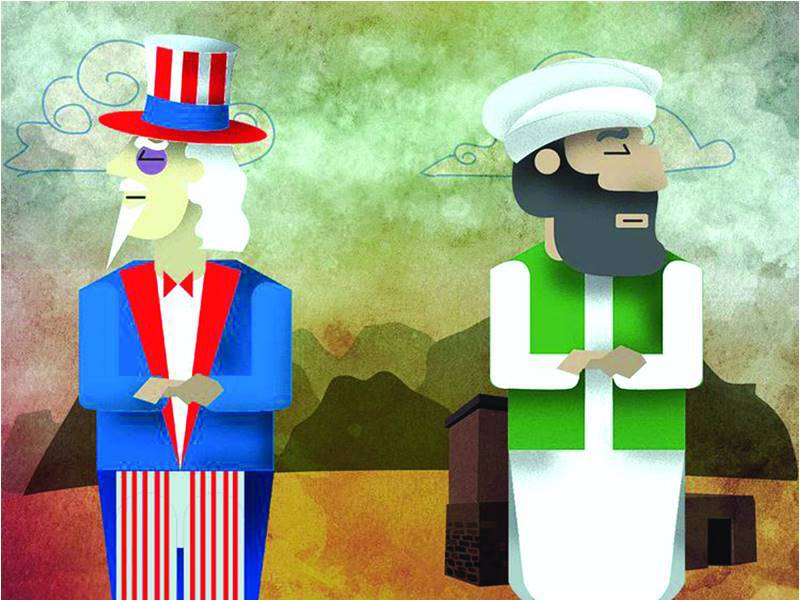
As the United States and Taliban inched closer to a historic deal that would enable the Americans to extricate itself from an 18-year-long war – their longest overseas military engagement – there were more concerns about the future of war-ravaged Afghanistan than celebrations about the return of foreign troops.
As these lines were being scripted on Wednesday evening, US and Taliban representatives, who had been for days saying that major issues had been finalized, were still busy tying the loose ends of their agreement.
The deal is essentially about US troops pulling out of Afghanistan in return for counter-terrorism assurances from the Taliban and the eventual commencement of an intra-Afghan process. Elements of special interest in the agreement, whose details may not be immediately revealed, would be the timeframe agreed by US for getting international forces out of Afghanistan and the kind and extent of residual presence that would be maintained there by US.
Some believe the troops withdrawal will be completed by end 2020 based on the ground situation and implementation of terms and conditions of the accord by Taliban. In the first phase the numbers of US troops would, however, reportedly be slashed by 6,000 from the current strength of a little over 14,000. Taliban have in the negotiations, which are now in the ninth round, moderated their initial stance that the pull out should be immediate and instant.
President Donald Trump has, meanwhile, renewed the debate about the residual US presence by talking about maintaining a strong intelligence footprint back in Afghanistan. Earlier there were reports about a special counter-terrorism contingent also being retained.
Close observers of the process, which is nearly a year old now, if one were to count the preliminary US–Taliban contacts in Doha last year, say that in addition to the size and scope of residual force, the issues that were being discussed before the conclusion of the latest round pertained to the implementation mechanism for the agreement, the role of international guarantors, and release of Taliban prisoners.
The progress in US-Taliban talks has undoubtedly been unprecedented. They may be closest to deal than ever before. But, at the same time the situation reeks of chaos and fear. These apprehensions are found both in Afghanistan and in the region. President Trump may be too enthusiastic about fulfilling his election promise of getting out of Afghanistan, but several in America are also apprehensive about the deal and its content.
Within US, there is scepticism about Taliban fulfilling their commitment. Senator Lindsay Graham voicing those concerns, in an interview, said, “Mr President, if you don’t have a counter-terrorism force left behind, even if you got to deal with the Taliban, which I doubt, but you might they have no capability or will to protect the American homeland. Every national security advisor to this president unanimously believes we need a robust counter-terrorism force to make sure that ISIS and al-Qaeda do not regenerate in Afghanistan to hit the American homeland.”
The world has been cautioning against a precipitous withdrawal because of fears that such an eventuality would be destabilizing for the region. That may, however, be addressed as the timeline is likely to be stretched over two years.
President Donald Trump sought to address some of those international concerns when he told journalists on the sidelines of G7 Summit in Biarritz, France, said that there was no rush to withdraw US forces from Afghanistan.
The fears of Afghans are more serious. It is a common perception in Afghanistan that US had only catered to its own interests in the agreement that is being finalized. For instance US had been insisting on counter-terrorism assurances from Taliban, but there are no demands about guarantees about women and minority rights. Similarly nothing is being done to ensure that the gains made by Afghan society over the past 18 years are not reversed.
Parties to the deal, especially US, must make the US-Taliban agreement public to win ownership for it by assuring the people of Afghanistan it was a win–win arrangement and not one that barters away their interest for securing US.
All these issues have been left to a subsequent intra-Afghan dialogue. It is believed that the Afghan dialogue, which is likely to take place in Oslo, would deal with the post-peace political and governance structures in Afghanistan. In view of the deep divisions in Afghan society and intense political polarization there, the dialogue will be extremely intense and complicated. The prospects of an intra-Afghan deal are therefore bleak. Many think that intra-Afghan process may take longer to reach a settlement.
Ideally the Americans should have insisted on holding an intra-Afghan dialogue in tandem with the US-Taliban negotiations. However, the US side succumbed to the Taliban pressure, who were staunchly opposed to talking to the Afghan government till a deal with Americans is reached, for ensuring that their own parleys remained alive.
The writer is a senior researcher at Islamabad Policy Institute. She can be reached at mamoona.rubab@ipipk.org
As these lines were being scripted on Wednesday evening, US and Taliban representatives, who had been for days saying that major issues had been finalized, were still busy tying the loose ends of their agreement.
The deal is essentially about US troops pulling out of Afghanistan in return for counter-terrorism assurances from the Taliban and the eventual commencement of an intra-Afghan process. Elements of special interest in the agreement, whose details may not be immediately revealed, would be the timeframe agreed by US for getting international forces out of Afghanistan and the kind and extent of residual presence that would be maintained there by US.
Some believe the troops withdrawal will be completed by end 2020 based on the ground situation and implementation of terms and conditions of the accord by Taliban. In the first phase the numbers of US troops would, however, reportedly be slashed by 6,000 from the current strength of a little over 14,000. Taliban have in the negotiations, which are now in the ninth round, moderated their initial stance that the pull out should be immediate and instant.
President Donald Trump has, meanwhile, renewed the debate about the residual US presence by talking about maintaining a strong intelligence footprint back in Afghanistan. Earlier there were reports about a special counter-terrorism contingent also being retained.
Close observers of the process, which is nearly a year old now, if one were to count the preliminary US–Taliban contacts in Doha last year, say that in addition to the size and scope of residual force, the issues that were being discussed before the conclusion of the latest round pertained to the implementation mechanism for the agreement, the role of international guarantors, and release of Taliban prisoners.
The progress in US-Taliban talks has undoubtedly been unprecedented. They may be closest to deal than ever before. But, at the same time the situation reeks of chaos and fear. These apprehensions are found both in Afghanistan and in the region. President Trump may be too enthusiastic about fulfilling his election promise of getting out of Afghanistan, but several in America are also apprehensive about the deal and its content.
Within US, there is scepticism about Taliban fulfilling their commitment. Senator Lindsay Graham voicing those concerns, in an interview, said, “Mr President, if you don’t have a counter-terrorism force left behind, even if you got to deal with the Taliban, which I doubt, but you might they have no capability or will to protect the American homeland. Every national security advisor to this president unanimously believes we need a robust counter-terrorism force to make sure that ISIS and al-Qaeda do not regenerate in Afghanistan to hit the American homeland.”
The world has been cautioning against a precipitous withdrawal because of fears that such an eventuality would be destabilizing for the region. That may, however, be addressed as the timeline is likely to be stretched over two years.
Some believe the troops withdrawal will be completed by end 2020 based on the ground situation and implementation of terms and conditions of the accord by Taliban
President Donald Trump sought to address some of those international concerns when he told journalists on the sidelines of G7 Summit in Biarritz, France, said that there was no rush to withdraw US forces from Afghanistan.
The fears of Afghans are more serious. It is a common perception in Afghanistan that US had only catered to its own interests in the agreement that is being finalized. For instance US had been insisting on counter-terrorism assurances from Taliban, but there are no demands about guarantees about women and minority rights. Similarly nothing is being done to ensure that the gains made by Afghan society over the past 18 years are not reversed.
Parties to the deal, especially US, must make the US-Taliban agreement public to win ownership for it by assuring the people of Afghanistan it was a win–win arrangement and not one that barters away their interest for securing US.
All these issues have been left to a subsequent intra-Afghan dialogue. It is believed that the Afghan dialogue, which is likely to take place in Oslo, would deal with the post-peace political and governance structures in Afghanistan. In view of the deep divisions in Afghan society and intense political polarization there, the dialogue will be extremely intense and complicated. The prospects of an intra-Afghan deal are therefore bleak. Many think that intra-Afghan process may take longer to reach a settlement.
Ideally the Americans should have insisted on holding an intra-Afghan dialogue in tandem with the US-Taliban negotiations. However, the US side succumbed to the Taliban pressure, who were staunchly opposed to talking to the Afghan government till a deal with Americans is reached, for ensuring that their own parleys remained alive.
The writer is a senior researcher at Islamabad Policy Institute. She can be reached at mamoona.rubab@ipipk.org

